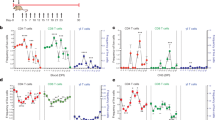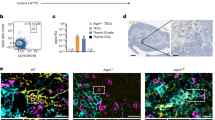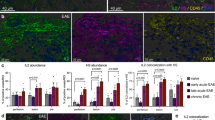Abstract
Intrathymic expression of tissue-specific self antigens may be involved in immunological tolerance and protection from autoimmune disease. We have analyzed the role of T-cell tolerance to proteolipid protein (PLP), the main protein of the myelin sheath, in susceptibility to experimental autoimmune encephalomyelitis (EAE), an animal model for multiple sclerosis. Intrathymic expression of PLP was largely restricted to the shorter splice variant, DM20. Expression of DM20 by thymic epithelium was sufficient to confer T-cell tolerance to all epitopes of PLP in EAE-resistant C57BL/6 mice. In contrast, the major T-cell epitope in SJL/J mice was only encoded by the central nervous system-specific exon of PLP, but not by thymic DM20. Thus, lack of tolerance to this epitope offers an explanation for the exquisite susceptibility of SJL/J mice to EAE. As PLP expression in the human thymus is also restricted to the DM20 isoform, these findings have implications for selection of the autoimmune T-cell repertoire in multiple sclerosis.
This is a preview of subscription content, access via your institution
Access options
Subscribe to this journal
Receive 12 print issues and online access
$209.00 per year
only $17.42 per issue
Buy this article
- Purchase on Springer Link
- Instant access to full article PDF
Prices may be subject to local taxes which are calculated during checkout



Similar content being viewed by others
References
Kisielow, P. & von Boehmer, H. Development and selection of T cells: facts and puzzles. Adv. Immunol. 58, 87–209 (1995).
Stockinger, B. T lymphocyte tolerance: From thymic deletion to peripheral control mechansims . Adv. Immunol. 71, 229– 265 (1999).
Anderton, S., Burkhart, C., Metzler, B. & Wraith, D. Mechanisms of central and peripheral T-cell tolerance: lessons from experimental models of multiple sclerosis. Immunol. Rev. 169, 123–137 (1999).
Alferink, J., Aigner, S., Reibke, R., Hämmerling, G.J. & Arnold, B. Peripheral T-cell tolerance: the contribution of permissive T-cell migration into parenchymal tissues in the neonate. Immunol. Rev. 169, 255–261 ( 1999).
Kojima, K., Reindl, M., Lassmann, H. & Wekerle, H., The thymus and self tolerance: Co-existence of encephalitogenic S100β-specific T cells and their nominal autoantigen in the normal adult rat thymus. Int. Immunol. 9, 897–904 (1997).
Hanahan, D., Peripheral-antigen-expressing cells in thymic medulla: factors in self- tolerance and autoimmunity. Curr. Opin. Immunol. 10, 656–662 (1998).
Klein, L., Klein, T., Rüther, U. & Kyewski, B. CD4 T-cell tolerance to human C-reactive protein, an inducible serum protein, is mediated by medullary thymic epithelium. J. Exp. Med. 188, 5–16 (1998).
Heath, V.L., Moore, N.C., Parnell, S.M. & Mason, D.W. Intrathymic expression of genes involved in organ specific autoimmune disease . J. Autoimmun. 11, 309– 318 (1998).
Sospedra, M., et al. Transcription of a broad range of self-antigens in human thymus suggests a role for central mechanisms in tolerance toward peripheral antigens . J. Immunol. 161, 5918– 5929 (1998).
Steinman, L. Multiple sclerosis: A coordinated immunological attack against myelin in the central nervous system. Cell 85, 299– 302 (1996).
Nave, K.A., Lai, C., Bloom, F.E. & Milner, R.J. Splice site selection in the proteolipid protein (PLP) gene transcript and primary structure of the DM-20 protein of central nervous system myelin. Proc. Natl. Acad. Sci. USA 84, 5665–5669 (1987).
Pribyl, T.M., Campagnoni, C., Kampf, K., Handley, V.W. & and Campangnoni, A.T. The major myelin protein genes are expressed in the human thymus. J. Neurosci. Res. 45, 812–819 (1996).
Voskuhl, R.R. Myelin protein expression in lymphoid tissues: Implications for peripheral tolerance. Immunol. Rev. 164, 81– 92 (1998).
Martin, R., McFarland, H.F. & McFarlin, D.E. Immunological aspects of demyelinating diseases. Annu. Rev. Immunol. 10, 153–187 (1992).
Wekerle, H. Experimental autoimmune encephalomyelitis as a model of immune-mediated CNS disease. Curr. Opin. Neurobiol. 3, 779– 784 (1993).
Tuohy, V.K., Sobel, R.A. & Lees, M.B. Myelin proteolipid protein-induced experimental allergic encephalomyelitis. Variations of disease susceptibility in different strains of mice. J. Immunol. 140, 1868– 1873 (1988).
Encinas, J.A., et al. Genetic analysis of susceptibility to experimental autoimmune encephalomyelitis in a cross between SJL/J and B10.S mice. J. Immunol. 157, 2186–2192 ( 1996).
Butterfield, R.J., et al. New genetic loci that control susceptibility and symptoms of experimental allergic encephalomyelitis in inbred mice. J. Immunol. 161, 1860–1867 ( 1998).
Encinas, J.A., et al. QTL influencing autoimmune diabetes and encephalomyelitis map to a 0.15-cM region containing IL2. Nature Genet. 21, 158–160 (1999).
Wekerle, H., Bradl, M., Linington, C., Kaab, G. & Kojima, K. The shaping of the brain-specific T lymphocyte repertoire in the thymus. Immunol. Rev. 149, 231– 243 (1996).
Harrington, C.J., et al. Differential tolerance is induced in T-cells recognizing distinct epitopes of myelin basic protein. Immunity 8, 571–580 (1998).
Targoni, O.S. & Lehmann, P.V. Endogenous myelin basic protein inactivates the high avidity T cell repertoire. J. Exp. Med. 187, 2055–2065 (1998).
Klugmann, M., et al. Assembly of CNS myelin in the absence of proteolipid protein . Neuron 18, 59–70 (1997).
Oukka, M., et al. CD4 T-cell tolerance to nuclear proteins induced by medullary thymic epithelium. Immunity 4, 545– 553 (1996).
Smith, K.M., Olson, D.C., Hirose, R. & Hanahan, D. Pancreatic gene expression in rare cells of the thymic medulla: Evidence for functional contribution to T-cell tolerance. Int. Immunol. 9, 1355 –1365 (1997).
Fritz, R.B. & Zhao, M.-L. Active and passive experimental autoimmune encephalomyelitis in strain 129/J (H-2b) mice. J. Neurosc. Res. 45, 471–474 (1996).
Tuohy, V.K., Zu, Z., Sobel, R.A., Laursen, R.A. & Lees, M.B. Identification of an encephalitogenic determinant of myelin proteolipid protein for SJL/J mice. J. Immunol. 142, 1523–1527 (1989).
Greer, J.M., Kuchroo, V.K., Sobel, R.A. & Lees, M.B. Identification and characterization of a second encephalitogenic determinant of myelin proteolipid protein (178–191) for SJL/J mice. J. Immunol. 149, 783–788 (1992)
Greer, J.M., et al. Immunogenic and encephalitogenic epitope clusters of myelin proteolipid protein. J. Immunol. 156, 371 –379 (1995).
Tuohy, V.K. & Thomas, D.M. Sequence 104–117 of myelin proteolipid protein is a cryptic encephalitogenic T-cell determinant for SJL/J mice. J. Neuroimmunol. 56, 161– 170 (1995).
Miller, S.D., et al. Evolution of the T-cell repertoire during the course of experimental immune-mediated demyelinating diseases. Immunol. Rev. 144, 225–244 (1995).
McRae, B.L., Vanderlugt, C.L., Dal Canto, M.C. & Miller, S.D. Functional evidence for epitope spreading in the relapsing pathology of experimental autoimmune encephalomyelitis. J. Exp. Med. 182, 75–85 (1995).
Yu, M., Johnson, J.M. & Tuohy, V.K. A predictable sequential determinant spreading cascade invariably accompanies progression of experimental autoimmune encephalomyelitis: A basis for peptide-specific therapy after onset of clinical disease. J. Exp. Med. 183, 377–383 (1996).
Miller, S.D., et al. Persistent infection with Theiler's virus leads to CNS autoimmunity via epitope spreading. Nature Med. 3, 1333 –1136 (1997).
Vanderlugt, C.L., et al. The functional significance of epitope spreading and its regulation by co-stimulatory molecules. Immunol. Rev. 164, 63–72 (1998).
Tuohy, V.K., et al. The epitope spreading cascade during progression of experimental autoimmune encephalomyelitis and multiple sclerosis. Immunol. Rev. 164, 93–110 ( 1998).
Segal, B.M. & Shevach, E.M. IL-12 unmasks latent autoimmune disease in resistant mice. J. Exp. Med. 184, 771–775 (1996).
Chang, J.T., Shevach, E.M. & Segal, B.M. Regulation of interleukin (IL)-12 receptor beta2 subunit expression by endogenous IL-12: a critical step in the differentiation of pathogenetic autoreactive T cells. J. Exp. Med. 189 , 969–978 (1999).
Markovic-Plese, S., et al. T cell recognition of immunodominant and cryptic proteolipid protein epitopes in humans. J. Immunol. 155, 982–992 (1995).
Trotter, J., et al. T cell recognition of myelin proteolipid protein and myelin proteolipid peptides in the peripheral blood of multiple sclerosis and control subjects. J. Neuroimmunol. 15, 172– 178 (1998).
Tuohy, V.K., Yu, M., Kawcak, J.A. & Kinkel, R.P. Spontaneous regression of primary autoreactivity during chronic progression of experimental autoimmune encephalomyelitis and multiple sclerosis. J. Exp. Med. 189, 1033–1042 (1999).
Tuohy, V.K., Yu, M., Weinstock-Guttman, B. & Kinkel, R.P. Diversity and plasticity of self recognition during the development of multiple sclerosis. J. Clin. Invest . 99, 1682– 1690 (1997).
Egwuagu, C.E., Charukamnoetkanok, P. & Gery, I. Thymic expression of autoantigens correlates with resistance to autoimmune disease. J. Immunol. 159, 3109–3112 (1997).
Pugliese, A., et al. The Insulin gene is transcribed in the human thymus and transcription levels correlate with allelic variation at the INS VNTR-IDDM2 susceptibility locus for type 1 diabetes. Nature Genet. 15, 293–297 (1997).
Vafiadis, P., et al. Insulin expression in human thymus is modulated by INS VNTR alleles at the IDDM2 locus. Nature Genet. 15, 289–292 (1997).
Kyewski, B.A., Fathman, C.G. & Rouse, R.V. Intrathymic presentation of circulating non-MHC antigens by medullary dendritic cells. An antigen-dependent microenvironment for T cell differentiation. J. Exp. Med. 163, 231–246 (1986).
Acknowledgements
We thank B. Arnold and J. Trotter for suggestions on the manuscript; K. Hexel for support in cell sorting; and S. Hagl (Department of Cardiac Surgery, University of Heidelberg, Germany) for providing human thymic tissue. Support of this study by the German Cancer Research Center, the Deutsche Forschungsgemeinschaft (DFG Ky 7/-1 to B.K.), the International Agency for Research on Cancer (Research Training Fellowship to L.K.), and the National Institutes of Health (grants NS 36054 and NS 37476 to V.K.T.) is acknowledged.
Author information
Authors and Affiliations
Corresponding author
Rights and permissions
About this article
Cite this article
Klein, L., Klugmann, M., Nave, KA. et al. Shaping of the autoreactive T-cell repertoire by a splice variant of self protein expressed in thymic epithelial cells. Nat Med 6, 56–61 (2000). https://doi.org/10.1038/71540
Received:
Accepted:
Issue Date:
DOI: https://doi.org/10.1038/71540
This article is cited by
-
Non-mutational neoantigens in disease
Nature Immunology (2024)
-
The contribution of thymic tolerance to central nervous system autoimmunity
Seminars in Immunopathology (2021)
-
Mechanisms of sex hormones in autoimmunity: focus on EAE
Biology of Sex Differences (2020)
-
Thymic epithelial cell heterogeneity: TEC by TEC
Nature Reviews Immunology (2020)
-
The role of thymic tolerance in CNS autoimmune disease
Nature Reviews Neurology (2018)



